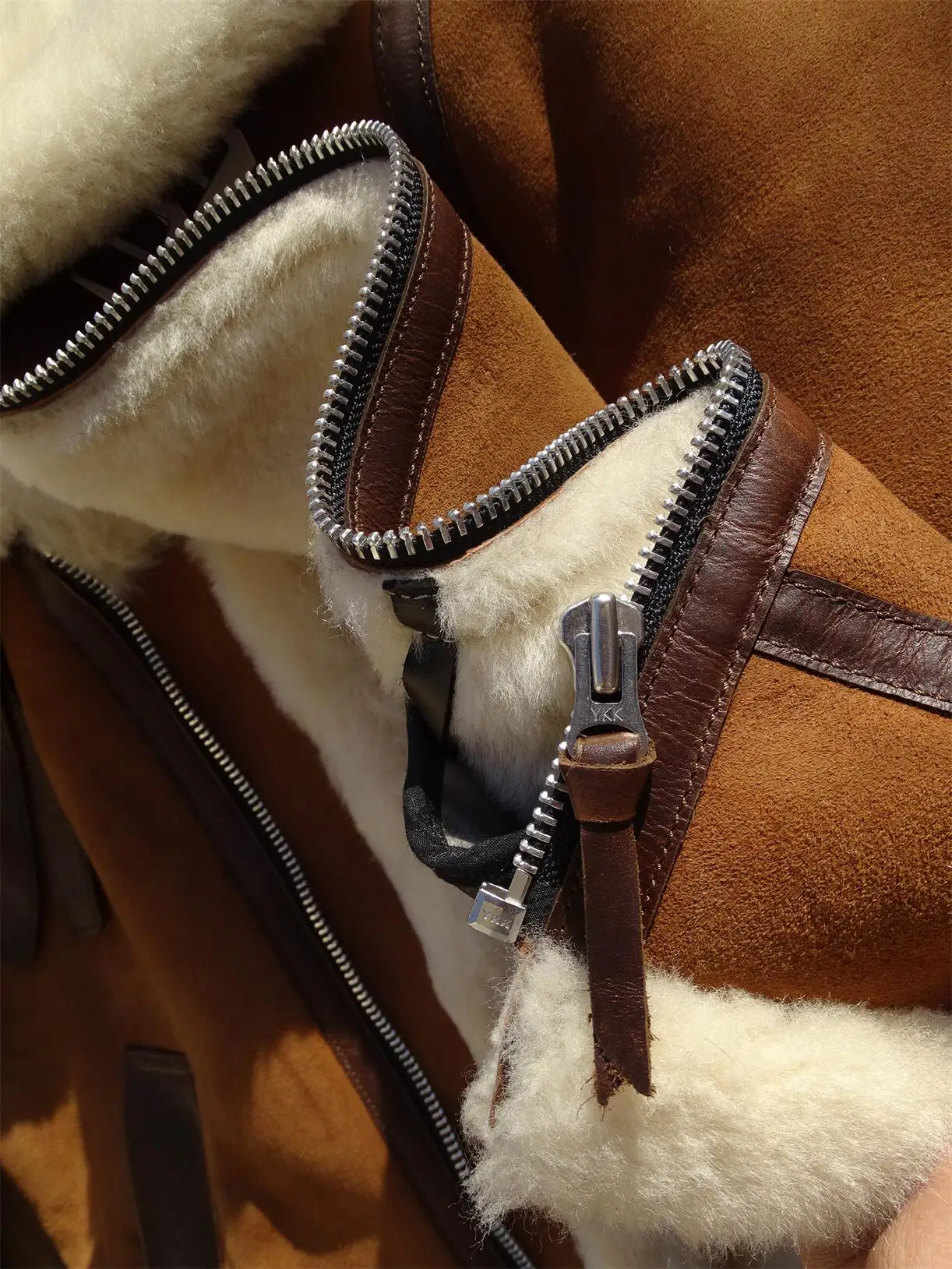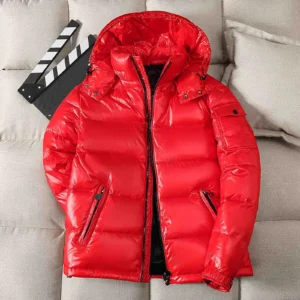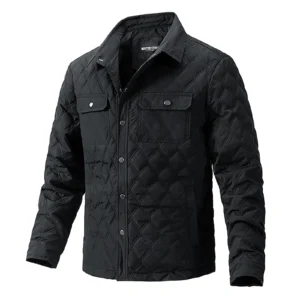Understanding the Value of Proper Leather Care
A quality leather coat is more than just a fashion statement—it’s an investment that can last for decades with proper care. Unlike synthetic materials that deteriorate within a few years, well-maintained leather develops character and patina over time, becoming more beautiful and uniquely yours with each passing season.
Leather’s natural properties make it both remarkably durable and surprisingly delicate. As a natural material, it breathes, flexes, and adjusts to your body while offering exceptional protection from the elements. However, these same organic qualities mean leather requires specific care to prevent drying, cracking, and premature aging.
At Metro Cloak, we’re committed to helping you protect your investment. Our expertise in premium men’s leather shearling coats has taught us that proper maintenance is the single most important factor in extending the life of fine leather garments. The difference between a coat that lasts five years and one that becomes a lifelong companion comes down to consistent, appropriate care.
This comprehensive guide will walk you through everything you need to know—from identifying your specific leather type to establishing routine care habits, cleaning techniques, conditioning methods, and storage solutions. We’ll also cover how to address common problems and when to seek professional assistance.
Understanding Your Leather Type: The Foundation of Proper Care
Before applying any cleaner, conditioner, or protectant to your leather coat, you must first identify what type of leather you’re working with. Different leathers require dramatically different care approaches, and what works wonderfully for one type could potentially ruin another.
Here’s how to identify common leather types found in quality coats:
Full-grain leather: The highest quality and most durable leather available, featuring natural grain patterns and pores. It feels substantial, develops a beautiful patina over time, and may show natural markings like small scars or wrinkles—signs of authenticity rather than flaws.
Top-grain leather: Slightly thinner than full-grain after having the uppermost surface sanded away. It offers a more uniform appearance with fewer natural marks and excellent durability. The surface often feels smoother and more consistent than full-grain.
Suede: Created from the underside of the hide, suede has a distinctive napped (fuzzy) surface that’s incredibly soft to the touch. It’s highly absorbent and requires specialized care to maintain its velvety texture.
Nubuck: Similar to suede but made from the outer side of the hide that’s been sanded or buffed to create a short, fine nap. It’s slightly more durable than suede but still requires special care. Nubuck has a more consistent, shorter nap than most suedes.
Patent leather: Features a high-gloss, glossy finish created through a coating process. It’s distinctive for its mirror-like shine and smooth, non-porous surface that repels water but can be prone to cracking if not maintained properly.
Lambskin/Nappa: Exceptionally soft and lightweight leather with a supple, almost buttery feel. While luxurious, it requires gentle handling and more frequent conditioning to maintain its delicate structure.
Not sure what type of leather your coat is? Try these simple identification methods:
- Check the tag or documentation that came with your coat for material information
- The water drop test: Place a small drop of water on an inconspicuous area. On finished leathers, water will bead up and can be wiped away. On suede or nubuck, it will absorb quickly and potentially leave a mark.
- Texture assessment: Run your hand over the surface. Smooth, slightly firm leather is likely full-grain or top-grain. A velvety, fuzzy surface indicates suede or nubuck.
Understanding your specific leather coat type is essential for selecting appropriate care products. For instance, a conditioner perfect for smooth leather could permanently darken or stain suede, while sheepskin coats require specialized care for both the leather exterior and wool interior.
Essential Leather Care Products: Building Your Maintenance Arsenal
Investing in quality leather care products is a fraction of the cost of replacing your coat and will significantly extend its lifespan. Here’s what you’ll need in your leather care toolkit:
Essential Products:
Leather cleaner: Always choose pH-neutral formulations specifically designed for leather. All-purpose cleaners can strip natural oils and damage the finish. Different types of leather cleaners work best for different leather finishes.
Leather conditioner: These restore essential moisture and prevent drying and cracking. Select conditioners formulated for your specific leather type—what works for smooth leather won’t work for suede. Learning how to properly oil your leather jacket can dramatically extend its life.
Leather protectant: Creates an invisible barrier against water, stains, and UV damage without changing the leather’s appearance or breathability.
Brushes and cloths:
- Soft-bristled brush for suede and nubuck
- Horsehair brush for smooth leathers
- Microfiber cloths for application and buffing
Cotton cloths (lint-free) for cleaning
Specialized tools:
- Suede eraser for spot cleaning
- Leather edge dressing for seams and edges
- Sponge applicators for even conditioner distribution
Essential Care Tools Table:
| Tool | Purpose | Best For |
|---|---|---|
| Horsehair brush | General cleaning, buffing | Smooth leathers |
| Suede brush | Raising nap, removing dry dirt | Suede, nubuck |
| Microfiber cloth | Applying products, buffing | All leather types |
| Leather cleaner | Removing dirt and stains | Type-specific formulas |
| Leather conditioner | Restoring moisture | Smooth leathers primarily |
| Water/stain repellent | Preventative protection | All leather types (formula-specific) |
| Cedar hanger | Proper storage | All leather coats |
| Breathable garment bag | Dust protection | Long-term storage |
Avoid common household products like dish soap, vinegar, or olive oil, despite what internet hacks might suggest. These can cause long-term damage even if they appear to work initially. Quality leather care products are specially formulated with the correct pH and ingredients that work with leather’s natural properties rather than against them.
Routine Care Schedule: Preserving Your Leather Coat Day to Day
Establishing a regular maintenance schedule is the key to preserving your leather coat’s beauty and extending its lifespan. The right long-term leather coat care routine prevents problems before they start, saving you time and protecting your investment.
After Each Wear (1-2 minutes):
* Hang your coat on a broad, padded hanger to maintain its shape
* Gently wipe away any visible dirt or moisture with a soft cloth
* Allow to air dry completely before storing if exposed to moisture
* Brush smooth leather with a horsehair brush to remove surface dirt
* For suede or nubuck, lightly brush with a suede brush in one direction
Weekly Maintenance (5 minutes):
* Inspect for new stains, scuffs, or problem areas
* Check stress points like elbows, cuffs, and collar for early signs of wear
* Brush more thoroughly to remove accumulated dust and dirt
* Spot clean any small new stains before they set
Monthly Deep Care (15-30 minutes):
* Perform a thorough cleaning as needed
* Apply conditioner to smooth leathers if they feel dry
* Test protection by observing if water still beads on the surface
* Inspect and clean the lining of perspiration buildup
Seasonal Transition Care (30-60 minutes):
* Before storage: Clean thoroughly, condition, and protect
* Before wearing season: Remove from storage, air out, inspect, and refresh protection
Environmental factors significantly impact care frequency. In dry climates or heated indoor environments, conditioning may be needed more often. In humid environments, watch for mold or mildew. If you live in areas with harsh winters, salt exposure requires immediate attention to prevent permanent damage.
Pay special attention to high-wear areas:
* Collar: Oils from hair and skin accumulate here
* Cuffs: Friction and handling cause accelerated wear
* Pockets: Frequent hand insertion transfers oils and dirt
* Elbow areas: Stretching and compression stress the leather
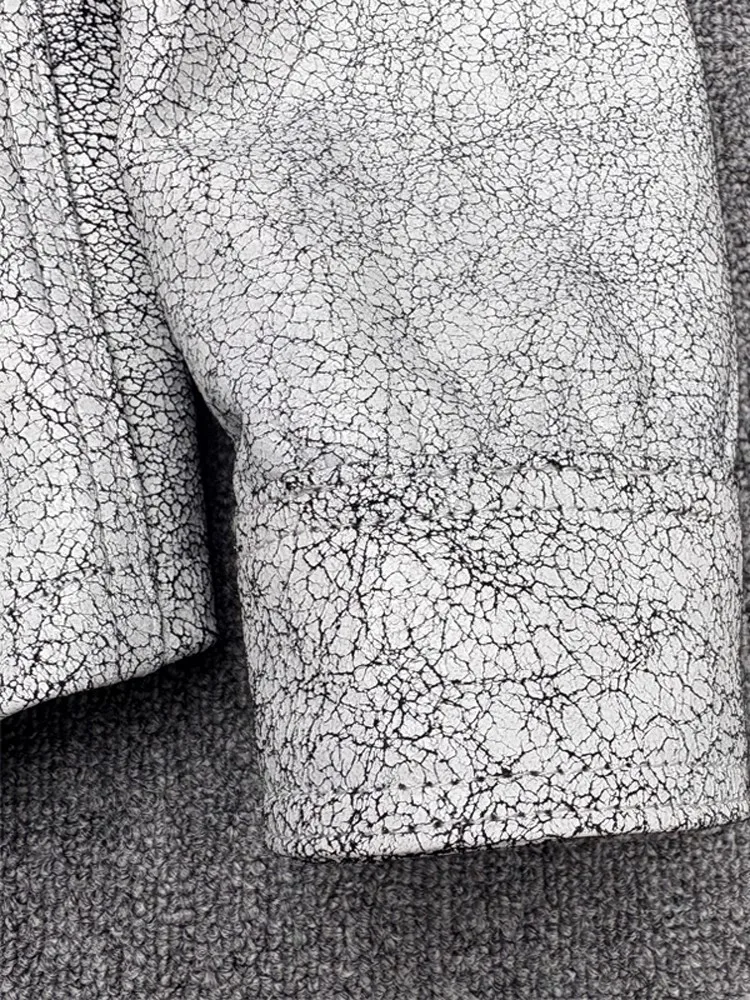
Cleaning Techniques: Removing Dirt and Stains Without Damage
Proper cleaning is essential for maintaining your leather coat’s appearance without causing damage. The key is to use gentle methods appropriate for your specific leather type.
Before You Clean:
1. Identify your leather type (refer to section II)
2. Test any product on an inconspicuous area first
3. Work in a well-ventilated area
4. Prepare clean cloths, appropriate brushes, and suitable leather cleaner
General Cleaning for Smooth Leather:
1. Remove surface dust with a soft brush or dry cloth
2. Apply a small amount of leather cleaner to a damp cloth—never directly to the leather
3. Work in small sections using gentle circular motions
4. Wipe away cleaner with a separate damp cloth
5. Allow to dry naturally away from direct heat or sunlight
6. Condition after cleaning once fully dry
Learning to clean your leather coat at home properly will save money while ensuring the best care. For black leather coats, use colorless products to avoid altering the finish.
Suede and Nubuck Cleaning:
1. Use a suede brush to remove surface dirt, brushing in one direction
2. For stubborn dirt, use a suede eraser with gentle pressure
3. For cleaning, use only products specifically formulated for suede
4. Apply cleaner with a soft cloth, working in the direction of the nap
5. Allow to dry completely before brushing to restore the nap
Addressing Common Stains:
Water Spots and Rain Damage:
* For smooth leather: Wipe entire panel evenly with a slightly damp cloth to blend the water mark
* For suede: Allow to dry completely, then brush gently to restore nap
Oil and Grease:
* Act quickly and blot (don’t rub) with a clean, absorbent cloth
* Apply cornstarch or talcum powder to absorb oil, let sit for several hours, then brush away
* For persistent stains, use a leather degreaser specifically formulated for your leather type
Ink and Pen Marks:
* For fresh ink on finished leather, try a small amount of isopropyl alcohol on a cotton swab
* For set-in stains or suede/nubuck, seek professional help to avoid spreading the stain
Road Salt and Winter Elements:
* Mix equal parts water and white vinegar
* Dampen a cloth with the solution and wipe affected areas
* Follow immediately with a clean, damp cloth to remove vinegar
* Allow to dry naturally, then condition smooth leather
Food and Beverage Spills:
* Blot immediately, don’t rub
* Clean with appropriate leather cleaner
* For protein-based stains (milk, blood), use cold water-based cleaning methods
* For sugar-based stains (soda, juice), use slightly warm water-based cleaning
Remember: When in doubt about a stain removal method, test in an inconspicuous area first or consult a professional. Incorrect cleaning attempts often make stains permanent.
Conditioning: Restoring Moisture and Preventing Cracks
Leather conditioning is essential for maintaining your coat’s suppleness and preventing the dreaded cracking that can render even expensive garments unwearable. Think of conditioning as moisturizing for your leather—it replaces natural oils that evaporate over time.
Why Conditioning Matters:
Leather is a natural material that requires moisture to remain flexible. Without regular conditioning, leather becomes dry, stiff, and eventually develops cracks that cannot be repaired. Proper leather coat conditioning preserves both appearance and structural integrity.
Signs Your Leather Coat Needs Conditioning:
* Leather feels stiff or less supple than when new
* Surface appears dull or faded
* Visible dryness, especially in creased areas
* Light scratches that don’t buff out
* Leather feels rough rather than smooth
* Visible fine lines beginning to form (early cracking)
The frequency of conditioning depends on several factors:
* Climate (drier climates require more frequent conditioning)
* Frequency of wear
* Exposure to elements
* Storage conditions
* Leather type and quality
Preventing leather coat cracks requires proactive conditioning before damage occurs—once cracks develop, they can only be minimized, not eliminated.
Conditioning Procedure for Smooth Leather:
1. Ensure leather is clean and completely dry
2. Apply a small amount of conditioner to a soft cloth
3. Work in small, overlapping circular motions
4. Use light pressure—let the conditioner absorb naturally
5. Pay extra attention to stress points (elbows, seams, collar)
6. Allow 15-20 minutes for absorption
7. Buff gently with a clean cloth to remove excess
8. Allow to dry for 24 hours before wearing
Special Considerations:
* Full-grain and top-grain leather: Can handle most conditioners; use matching color or neutral
* Lambskin: Requires very light conditioning with specialized products
* Suede and nubuck: Use only specialized spray conditioners designed for napped leathers
* Patent leather: Needs minimal conditioning with specialized patent products only
* Colored leather: Test conditioner on an inconspicuous area to ensure it won’t darken or alter color
Conditioning Frequency Guidelines:
* Heavy wear (daily): Every 1-3 months
* Moderate wear: Every 3-6 months
* Light wear or storage: Every 6-12 months
* After any cleaning with leather cleaner
* Before and after seasonal storage
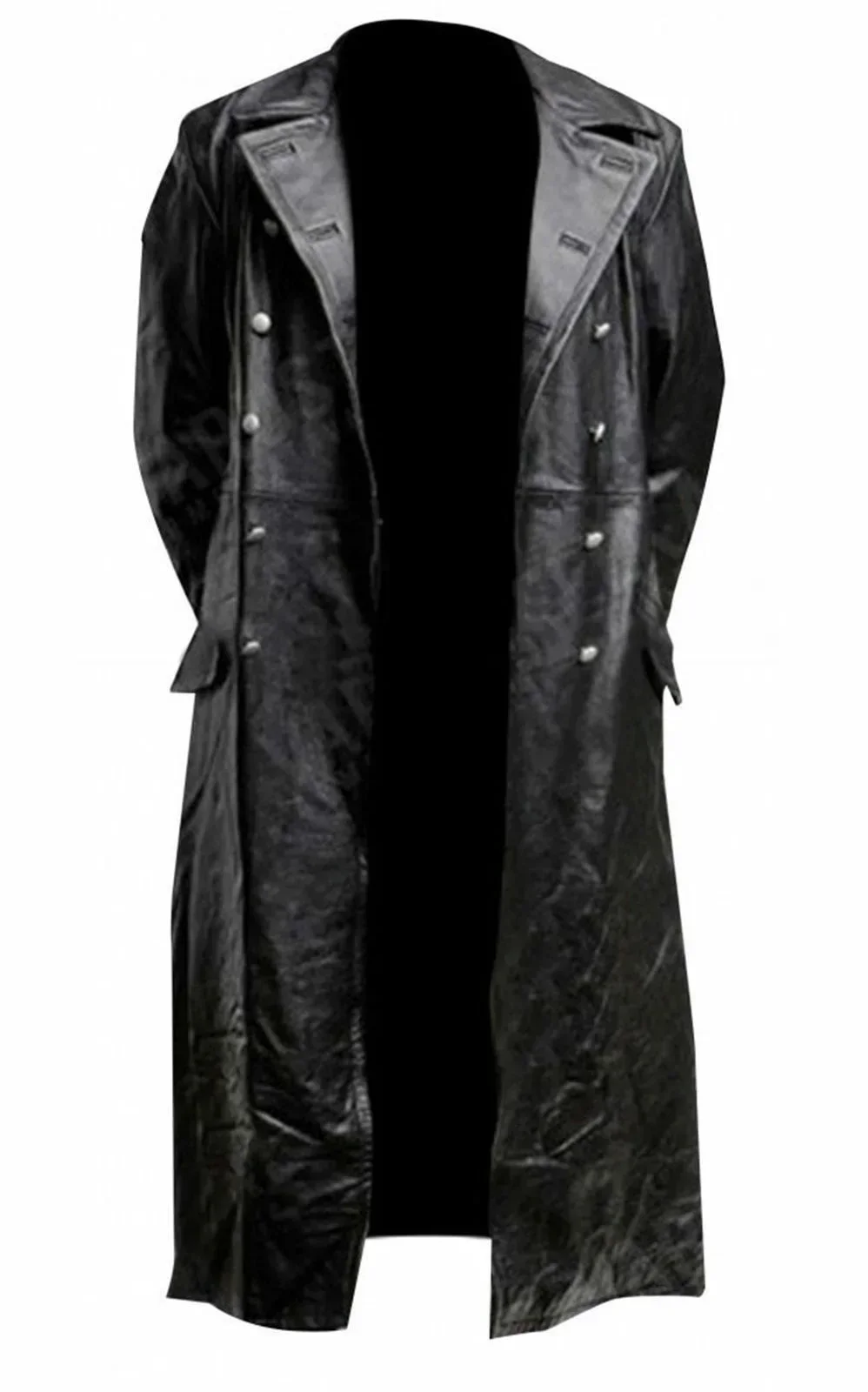
Protection: Safeguarding Against the Elements
Protecting your leather coat from environmental damage is a crucial step that many owners unfortunately skip. Proper protection creates an invisible barrier against water, stains, UV rays, and pollutants without affecting the leather’s appearance or breathability.
Benefits of Protective Treatments:
* Prevents water and liquid stains from penetrating the leather
* Creates time to clean spills before they cause damage
* Reduces UV fading and sun damage
* Minimizes the absorption of airborne pollutants
* Decreases cleaning frequency by repelling dirt
Understanding how to waterproof your leather coat properly is essential for maintaining its appearance during inclement weather. It’s important to note that leather protection provides water resistance, not complete waterproofing—extended exposure to heavy rain will eventually saturate even protected leather.
Applying Protective Treatments:
1. Always start with clean, dry leather
2. Apply protector in a well-ventilated area
3. Hold spray approximately 8-10 inches (20-25 cm) from the surface
4. Apply thin, even coats using a sweeping motion
5. Allow to dry completely between coats (typically 15-30 minutes)
6. Apply 2-3 light coats rather than one heavy application
7. Pay special attention to seams and exposed edges
8. Allow 24 hours for full curing before exposure to elements
For comprehensive leather jacket protection, consider the environmental challenges your coat will face. Those living in rainy climates should prioritize water repellency, while those in sunny areas need UV protection.
UV Protection Strategies:
* Use leather protectors with UV inhibitors
* Store your coat away from direct sunlight
* Avoid prolonged sun exposure, especially during peak hours
* Reapply UV protection more frequently if the coat is regularly exposed to sunlight
Special Weather Considerations:
* Heavy Rain: Apply additional protection before rainy seasons and always allow your coat to dry naturally if it gets wet
* Snow: Protect against both moisture and salt damage with appropriate repellents
* Extreme Cold: Condition before exposure to very cold conditions as leather can become brittle
* Intense Heat: Protect against drying with increased conditioning frequency and UV barriers
For winter coats that face harsh conditions, consider a more robust protection regimen with more frequent applications of protectant, especially at the beginning of the season.
Testing Protection Effectiveness:
Sprinkle a few drops of water on an inconspicuous area—water should bead up rather than absorb. If the water begins to soak in, it’s time to reapply protection.
Proper Storage: Preserving Your Leather Between Seasons
How you store your leather coat when not in use is just as important as how you care for it while wearing it. Proper storage prevents creasing, mold growth, and shape distortion that can permanently damage your investment.
Short-Term Storage (Daily/Weekly):
* Use a broad, contoured wooden or padded hanger (never wire)
* Allow space on either side for air circulation
* Keep away from direct sunlight and heat sources
* Allow the coat to “rest” between wears when possible
* Leave breathing room between garments in your closet
Long-Term Seasonal Storage:
The expert guide to long-term leather coat storage recommends a comprehensive approach:
- Clean and condition the coat thoroughly before storage
- Apply appropriate protectant
- Stuff sleeves and body with acid-free tissue paper to maintain shape
- Cover with a breathable cotton garment bag—never plastic, which traps moisture
- Store in a cool, dry place with stable temperature (ideally 60-75°F/15-24°C)
- Maintain moderate humidity (40-50%) to prevent drying
- Check periodically for signs of pest activity or mold
Ideal Environmental Conditions:
* Temperature: 60-75°F (15-24°C)
* Humidity: 40-50%
* Air circulation: Moderate
* Light exposure: Minimal, no direct sunlight
Storage Don’ts:
* Don’t use plastic bags or covers
* Don’t store in damp basements or hot attics
* Don’t compress with heavy items on top
* Don’t hang on hooks or narrow hangers that create pressure points
* Don’t store near radiators, heating vents, or in direct sunlight
Leather Type Specific Storage:
* Suede and nubuck: Extra protection from dust is essential; use a breathable cover
* Patent leather: Store with tissue between folds to prevent sticking
* Lambskin and soft leathers: Require more generous padding to prevent stretching
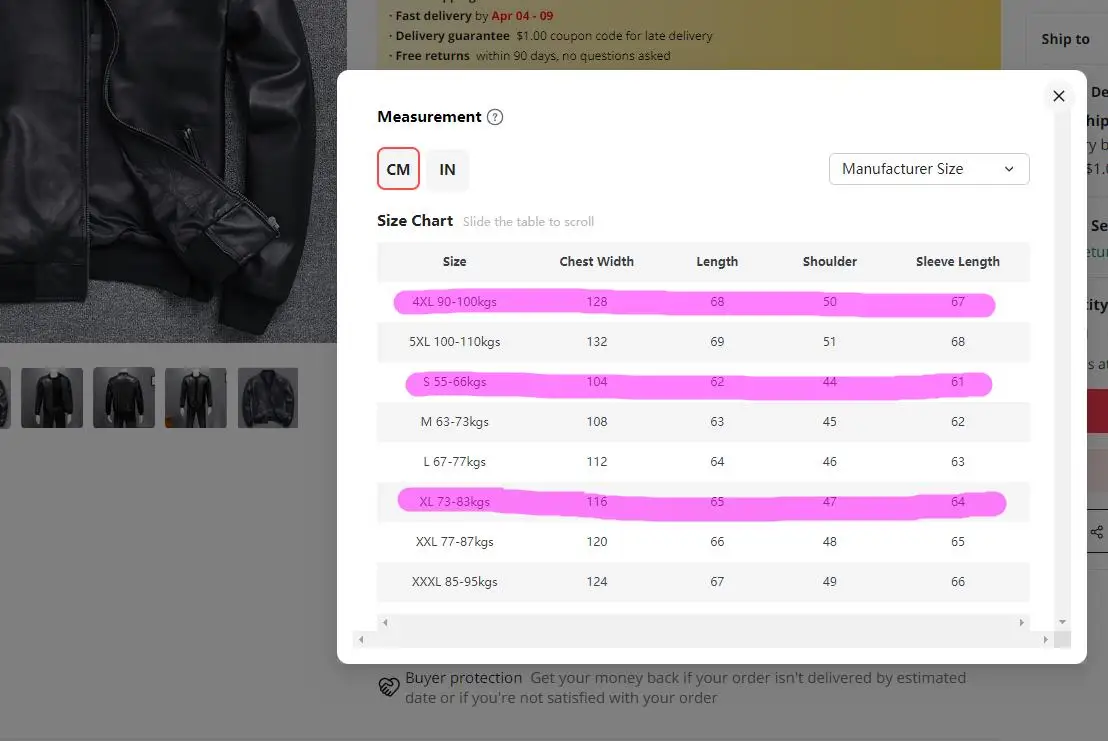
Addressing Minor Damage: DIY Repair Techniques
Even with excellent care, your leather coat may occasionally suffer minor damage. Fortunately, many common issues can be addressed at home with the right techniques and supplies.
Assessing DIY Repair Appropriateness:
Before attempting repairs, consider:
* Is the damage superficial or structural?
* Is the affected area highly visible?
* Do you have the appropriate tools and products?
* Are you comfortable potentially making a mistake?
When in doubt, consult a professional—especially for expensive or sentimental items.
Surface Scratches and Scuffs:
1. Clean the area with leather cleaner
2. For light scratches on smooth leather, gently rub with your finger (natural oils help)
3. Apply a small amount of matching leather conditioner
4. For deeper scratches, use a leather repair kit with colorant
5. Buff gently after treatment
Color Restoration for Faded Areas:
1. Clean thoroughly
2. Apply leather dye or colorant matched to your coat
3. Work in thin layers rather than one thick application
4. Allow to dry completely between coats
5. Seal with leather finisher once color is restored
Minor Tears and Splits:
1. Clean the edges of the tear
2. Apply leather glue to both sides using a toothpick
3. Press edges together firmly
4. Secure with leather repair tape until completely dry
5. Apply leather conditioner after repair is set
Loose Buttons or Hardware:
1. Check if the hardware can be tightened
2. For buttons, use heavy-duty thread and a leather needle
3. Reinforce from the back side when possible
4. Consider adding a small backing piece for additional support
Lining Repairs:
1. Use similar fabric and thread that matches the lining
2. Hand-stitch with small, even stitches
3. For larger tears, consider iron-on patches from the inside
For specialized leathers like shearling coats, repairs become more complex due to the wool interior. These often require professional attention, especially for tears or damage that affects both the leather exterior and wool lining.
When to Skip DIY and Seek Professional Help:
* Tears longer than 1 inch (2.5 cm)
* Damage on highly visible areas like the front or collar
* Color damage that affects large areas
* Structural damage to seams or stress points
* Damage to expensive or rare leathers
* When you’re uncertain about the repair method
Remember that improper DIY repairs can actually decrease the value of your coat and make professional restoration more difficult later.
Mens Heavy Winter Coat, Mens Insulated Coat, Mens Parka Coat
Price range: $175.52 through $237.36 Select options This product has multiple variants. The options may be chosen on the product pageMens Big and Tall Winter Coats, Mens Down Coat, Mens Hooded Winter Coat, Mens Puffer Coat
Price range: $126.44 through $217.01 Select options This product has multiple variants. The options may be chosen on the product pageMens Big and Tall Winter Coats, Mens Hooded Winter Coat
Price range: $80.32 through $106.68 Select options This product has multiple variants. The options may be chosen on the product pageMens Cashmere Overcoat, Mens Hooded Winter Coat, Mens Wool Blend Coat
Price range: $128.72 through $139.68 Select options This product has multiple variants. The options may be chosen on the product pageMens Hooded Winter Coat, Mens Insulated Coat, Mens Puffer Coat, Mens Quilted Coat
Price range: $139.88 through $177.72 Select options This product has multiple variants. The options may be chosen on the product pageMens Double Breasted Pea Coat, Mens Hooded Winter Coat, Mens Quilted Coat
Price range: $81.00 through $108.48 Select options This product has multiple variants. The options may be chosen on the product page
Specialized Care for Different Leather Finishes
Each leather type has unique characteristics that require specialized care approaches. Understanding these differences ensures your specific leather receives optimal treatment.
Full-Grain and Top-Grain Leather:
* Clean with pH-balanced leather cleaner
* Condition every 3-6 months with quality leather conditioner
* Can handle more robust cleaning than delicate leathers
* Develop desirable patina with proper care and use
* May darken slightly with conditioning—test first
* Benefit from regular brushing with horsehair brush
Suede and Nubuck Care:
* Never use liquid cleaners meant for smooth leather
* Clean with suede brush, eraser, or specialized suede cleaner
* Always brush in one direction to maintain consistent nap
* Use water-repellent spray specifically formulated for suede
* Address stains immediately as they’re more difficult to remove later
* Avoid handling with oily hands or touching with hair products
Patent Leather Maintenance:
* Clean with a damp cloth—patent leather cleaner for stubborn dirt
* Use specialized patent leather conditioner very sparingly
* Never use standard leather conditioners which will damage the finish
* Store with tissue between folds to prevent sticking
* Polish occasionally with specialized patent polish for restored shine
* Clean immediately after exposure to alcohol which can dissolve the finish
Lambskin/Nappa Delicate Handling:
* Clean with extremely gentle leather cleaners or specialized lambskin products
* Use minimal moisture when cleaning
* Apply very light conditioning with products specifically for fine leather
* Handle with clean hands to prevent oil transfer
* Store with ample padding to maintain shape
* Protect zealously from scratches as thin leather shows damage more readily
Vintage Leather Considerations:
* Clean more gently than newer leathers
* Condition more frequently as older leather tends to dry out
* Use conditioners with higher lanolin content for deep nourishment
* Test all products carefully as vintage dyes may be less stable
* Accept and preserve patina rather than trying to restore original appearance
* Address cracking immediately to prevent further deterioration
Brown leather coats often show more character development and patina changes than darker colors, making their specialized care particularly important for maintaining their rich appearance.

When to Seek Professional Help: Identifying Serious Issues
While routine maintenance and minor repairs can be handled at home, some situations require professional expertise. Knowing when to seek professional help can save your leather coat from permanent damage.
Scenarios Requiring Professional Leather Specialists:
* Deep cracks or splits in the leather
* Large tears, especially at seams or stress points
* Significant color loss or discoloration
* Water or liquid damage that has dried and stiffened the leather
* Mold or mildew growth
* Lining replacement or major repairs
* Alterations to fit
* Hardware replacement that requires disassembly
* Odor that persists despite cleaning attempts
* Restoration of vintage or heirloom pieces
Finding a Qualified Leather Professional:
* Seek specialists who work specifically with garments, not just furniture
* Ask about experience with your specific leather type
* Request examples of similar work they’ve completed
* Check reviews and ask for recommendations
* Inquire about their cleaning and conditioning methods
Questions to Ask Before Entrusting Your Coat:
* What products will be used on my leather?
* Is the work guaranteed?
* How long will the process take?
* What is the expected outcome?
* Are there any risks to the procedure?
* What maintenance do you recommend after the repair?
What to Expect from Professional Services:
* Initial assessment and detailed quote
* Explanation of the process and expected results
* Higher cost than DIY but with more reliable outcomes
* Typically 1-3 weeks turnaround depending on complexity
* Specific care instructions following the service
Long leather coats like our men’s long leather coats often represent a significant investment and may warrant professional maintenance every few years to ensure longevity.
Cost vs. Replacement Considerations:
Professional leather services typically cost between $50-$300 depending on the extent of work needed. While this might seem expensive, it’s significantly less than replacing a quality leather coat. Consider the original value of your coat and its sentimental worth when making this decision.
Leather Coat Care Do’s and Don’ts: Quick Reference Guide
| DO | DON’T |
|---|---|
| Hang on a broad, padded hanger | Use wire hangers or hooks |
| Clean spills immediately | Rub vigorously when cleaning |
| Test products in hidden areas first | Use household cleaners or soaps |
| Condition regularly based on leather type | Apply oil, petroleum jelly, or cooking oils |
| Allow wet leather to dry naturally | Use heat sources to speed drying |
| Store in breathable cotton covers | Store in plastic which traps moisture |
| Brush regularly to remove dust | Saturate leather with water |
| Apply protectant appropriate for leather type | Use all-purpose protectants not made for leather |
| Keep away from direct heat and sunlight | Store near radiators or sunny windows |
| Address small issues before they worsen | Attempt major repairs without expertise |
| Consult professionals for significant damage | Use alcohol-based products on leather |
| Rotate wear to allow “rest” between uses | Store long-term without conditioning first |
The difference between shearling and sheepskin coats will impact your care approach—understanding this distinction ensures you’re applying the right techniques to your specific garment.
Frequently Asked Questions: Expert Solutions to Common Concerns
How often should I clean my leather coat?
Clean as needed rather than on a fixed schedule. For regular wear, a thorough cleaning 1-2 times per year is typically sufficient. Spot clean stains immediately as they occur. Heavy wear or exposure to harsh conditions may require more frequent cleaning.
Can I use household products for cleaning leather?
No, avoid household products like dish soap, vinegar, or all-purpose cleaners. These often have incorrect pH levels that can strip natural oils and damage leather finishes. Always use cleaners specifically formulated for your type of leather.
How do I remove wrinkles from leather?
For minor wrinkles, hang the coat in a steamy bathroom (not in direct steam). For more serious wrinkles, use a garment steamer held 6-8 inches (15-20 cm) away from the leather, then hang to dry naturally. Never use an iron directly on leather.
Is it safe for my leather coat to get wet?
Brief exposure to light rain won’t damage properly protected leather, but you should dry it naturally as soon as possible. Extended exposure can lead to water staining, stiffening, and potentially mold. Never wear leather in heavy downpours if avoidable.
How do I remove odors from leather?
For mild odors, air the coat outside (not in direct sunlight) for several hours. For persistent odors, use a leather deodorizer specifically designed for garments. Avoid household air fresheners which can damage the finish. Professional cleaning may be necessary for severe odors.
Can I use products meant for furniture on my coat?
Generally no. Furniture leather is often finished differently than garment leather. Furniture products may be too heavy or contain ingredients that affect the flexibility needed in clothing. Always use products specifically formulated for leather garments.
How long should a quality leather coat last?
With proper care, a high-quality leather coat can last 20+ years. Premium coats with excellent maintenance can become heirloom items lasting generations. The key factors affecting longevity are leather quality, construction methods, and consistent maintenance.
Can I restore severely dried/cracked leather?
Minor dryness can often be restored through conditioning, but severe cracking is usually permanent damage. Professional leather restorers may improve the appearance and prevent further deterioration, but complete restoration is rarely possible once deep cracking occurs.
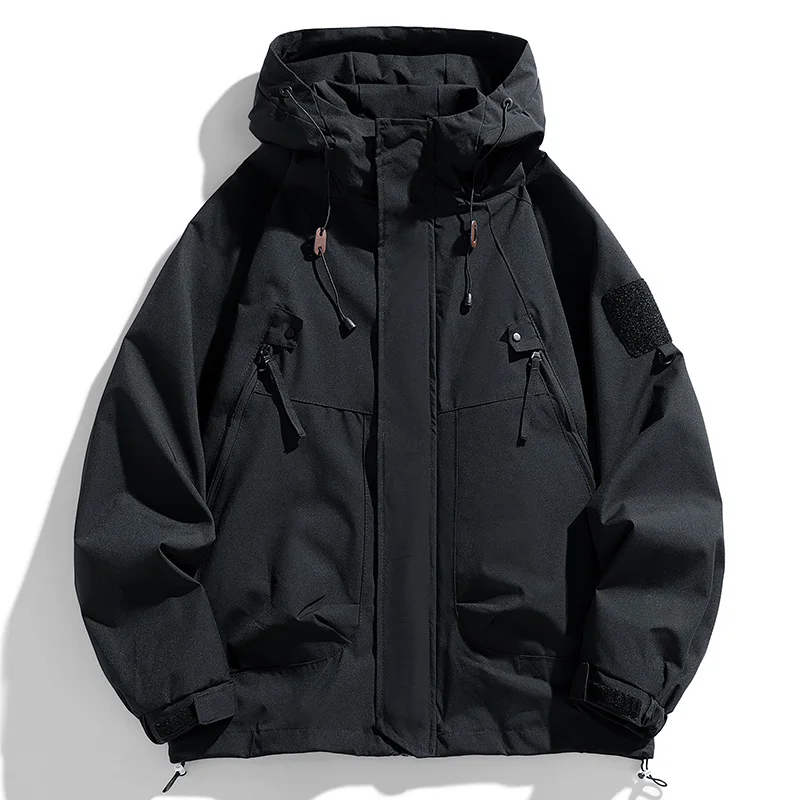
Supplemental Considerations: Special Scenarios and Advanced Care
Vintage and Heirloom Leather Coats:
Older leather requires more gentle handling and more frequent conditioning. The leather may have been tanned using methods different from modern techniques, potentially affecting how it responds to products. Start with very mild cleaners and light conditioning, gradually increasing as needed. Preserve patina rather than trying to restore a “new” appearance.
Hardware and Decorative Elements:
Metal hardware should be cleaned with a soft cloth and protected with a light application of appropriate metal polish. For decorative elements like embroidery or beading, clean around rather than directly on these features. Cover decorative elements when applying conditioners or protectants to the surrounding leather.
Lined vs. Unlined Leather Coats:
Lined coats require attention to both the leather exterior and the fabric lining. Clean linings according to their fabric type, using appropriate methods that won’t affect the leather. For perspiration odors in linings, a fabric freshener safe for delicate materials can help between professional cleanings.
Travel Considerations:
When traveling with leather coats, use a breathable garment bag and hang the coat whenever possible. For longer trips, a portable care kit containing leather wipes, a small brush, and a stain remover pen can address immediate issues. Always allow your coat to fully dry and air out after exposure to different climates before storing.
Eco-Friendly Leather Care:
Natural alternatives exist for conventional leather care products, though effectiveness varies. Beeswax-based conditioners provide good protection, while some plant-based conditioners work well for regular maintenance. Natural soap flakes diluted in distilled water can clean light soil. However, for significant issues or valuable coats, specially formulated leather care products often provide more reliable results.
Multi-Material Coats:
For leather coats with fur collars or trim, separate care is needed for each material. Fur requires brushing with a fur brush and should never be exposed to leather conditioners. For coats combining leather with fabric panels, clean each material according to its specific requirements, taking care to avoid product overlap at material boundaries.
The guide to men’s black leather jackets provides additional advanced care techniques for specific styles that combine different materials and finishes.
By following this comprehensive guide to leather coat maintenance, your investment piece will remain beautiful and functional for many years to come, developing character and a unique patina that only improves with time. Remember that consistent, appropriate care is always more effective than attempting to correct problems after they’ve developed.

